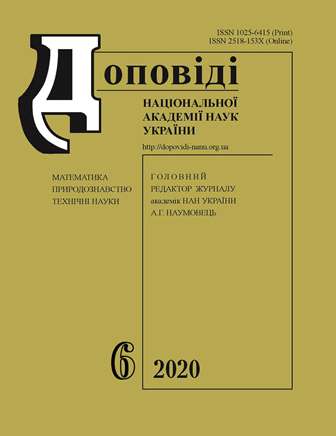Ізотермічний переріз діаграми стану системи Ti-Al-Ga при 850 °С
DOI:
https://doi.org/10.15407/dopovidi2020.06.030Ключові слова:
ізотермічний переріз діаграми стану, алюміній, галій, рентгенівська порошкова дифрактометрія, титанАнотація
В повному концентраційному інтервалі методом електродугової плавки виготовлені сплави подвійних базисних систем Ti—Al і Ti—Ga, а також сплави потрійної системи Ti—Al—Ga. З використанням методу рентгенівської порошкової дифрактометрії вивчено фазовий склад відпалених при 850 °С сплавів, в результаті чого підтверджено літературні відомості про існування при температурі відпалу сплавів чотирьох алюмінідів титану (Ti3Al, TiAl, r-TiAl2, TiAl3), восьми галідів титану (Ti3Ga, Ti2Ga, Ti5Ga3, Ti5Ga4, TiGa, Ti2Ga3, TiGa2 й TiGa3), а також показана відсутність утворення потрійних сполук. Встановлено, що ізоструктурні сполуки TiAl—TiGa, TiAl2—TiGa2 та TiAl3—TiGa3 утворюють в системі Ti—Al—Ga неперервні ряди твердих розчинів, а на основі подвійних галідів Ti2Ga3, Ti5Ga4 та Ti2Ga існують обмежені тверді розчини, області гомогенності яких витягнені до 15, 6 і 10 ат. % Al відповідно. Неперервні ряди твердих розчинів Ti(Al,Ga)3, Ti(Al,Ga)2, Ti(Al,Ga), обмежені тверді розчини Ti2(Ga,Al)3, Ti5(Ga,Al)4, Ti2(Ga,Al),, подвійні сполуки Ti3Al, Ti3Ga та твердий розчин на основі α-Ti (до 15 ат. % Al/Ga) формують фазові поля, з урахуванням яких в повному концентраційному інтервалі побудовано ізотермічний переріз діаграми стану системи Ti—Al—Ga при 850 ºС.
Завантаження
Посилання
Froes, F. H. (Ed.). (2015). Titanium: Physical Metallurgy, Processing, and Applications eBook. ASM International, Materials Park. Ohio 44073-0002.
Glazunov, S. G. & Yasinskij, K. K. (1993). Titanovye splavy dlya aviatsionnoj tekhniki i drugikh otraslej promy`shlennosti. Tekhnologiya legkikh splavov, 7-8, pp. 47-54 (in Russian).
Kitashima, T., Suresh, K. S., Yamabe-Mitarai, Y. & Iwasaki, S. (2014). Tensile Strength and Impact Toughness of Gallium-Bearing Near-α Titanium alloys. Materials Science Forum, 783, pp. 619-623.
Cochis, A., Azzimonti, B., Chiesa, R., Rimondini, L. & Gasik, M. M. (2019). Metallurgical Gallium Additions to Titanium Alloys Demonstrate a Strong Time-Increasing Antibacterial Activity without any Cellular Toxicity. ACS Biomater. Sci. Eng., 5, No. 6, pp. 2815-2820.
Antonova, N. V., Tretyachenko, L. A., Velikanova, T. Ya., &Martsenyuk, P. S. (1998). TiAl—TiGa section of the Ti—Al—Ga system. J. Alloys and Compounds, 264, pp. 167-172. https://doi.org/10.1016/S0925-8388(97)00257-0
Glazunov, S. G., Nikishov, O. A., Solonina, O. P., Sorokina, L. V., Ermolova, M. I. & Tkhorevskaya, Zh. D. (1974). Struktura i svojstva splavov sistemy` titan-alyuminij-gallij. Tekhnologiya legkikh splavov, No. 6, рр. 37-39 (in Russian).
Schuster, J. C. & Ipser, Y. (1990). Phases and phase relations in the partial system TiAl3—TiAl. Z. Metallk., 81, No. 6, pp. 389-396.
Kornilov, I. I., Py`laeva, E. I., Volkova, M. A., Kripyakevich, P. I. & Markiv, V. Ya. (1965). Fazovoe stroenie splavov dvojnoj sistemy` Ti—Al, soderzhashhikh ot 0 do 30 at. % Al. Dokl. akad. nauk. SSSR, 161, No. 4, pp. 843-846 (in Russian).
Okamoto, H. (2000). Al—Ti (Aluminum-Titanium). J. Phase Equilibria, 21, No. 3, p. 311. https://doi.org/10.1361/105497100770340101
Batalu, D., Cosmeleata, G. & Aloman, A. (2006). Critical analysis of the Ti-Al phase diagrams. UPB Sci. Bull., Series B, 68, No. 4, pp. 77-90.
Antonova, N. V. & Tretyachenko, L. A. (2001) Phase diagram of the Ti—Ga system. Journal of Alloys and Compounds, 317-318, pp. 398-405. https://doi.org/10.1016/S0925-8388(00)01416-X
Okamoto, H. (2002) Ga—Ti (Gallium-Titanium). J. Phase Equilibria, 23, No. 5, pp. 457-458. https://doi.org/10.1361/105497102770331505
##submission.downloads##
Опубліковано
Як цитувати
Номер
Розділ
Ліцензія
Авторське право (c) 2023 Доповіді Національної академії наук України

Ця робота ліцензується відповідно до Creative Commons Attribution-NonCommercial 4.0 International License.




